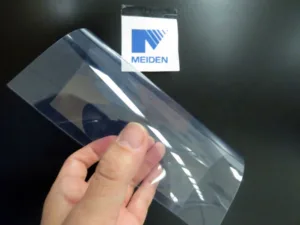Meidensha Corp. (Tokyo, Japan) has developed a technology to deposit oxide films at close to room temperature. Since one use of such films is as a barrier layer, the technology has the potential for use in applications that include flexible OLED displays and printed electronics.
First, a little background information.
Since the year 2000, researchers at Meidensha have been developing deposition technology in collaboration with the National Institute of Advanced Industrial Science and Technology (Tokyo, Japan). Up to now, the technology, as described in a series of scientific papers and in several patents, has related to the growth of silicon dioxide films. The films are grown directly on a silicon substrate through UV irradiation in a pure or highly concentrated ozone environment. (Meidensha is perhaps best known in the semiconductor industry for its pure ozone generator products.) A common feature in all of this previous work is the fact that the surface temperature experienced by substrates during processing reaches several hundred degrees Celsius.
This processing temperature is acceptable for a silicon substrate but it is too high to allow coating oxides directly on low temperature materials such as plastic sheeting. This is also true of the 100 – 150°C produced by the current low temperature alternative, plasma deposition. Meidensha’s new technology addresses this issue in that it can deposit oxide coatings at 30°C.
“The film formation technology using pure ozone first chemically combines ozone (O3) and ethylene (C2H4) to produce hydroxyl radicals (OH radicals). When the OH radicals are combined with tetraethylorthosilicate (SiC8H20O4, TEOS gas), it is decomposed into silicon dioxide (SiO2), carbon dioxide (CO2), water (H2O) and oxygen (O2). The CO2, H2O and O2 are discharged as impurities while only SiO2 precipitates from a high position onto a film. As a result, a high purity SiO2 film can be formed.”
Using the new process, the thickness of oxide film can be adjusted from 5nm to 780nm. The resulting films are described as:
- Damagelessness (which, in the context of this article, can be defined as meaning a film with minimal defects)
- Resistant to scratching
- Bendable
- Having excellent barrier properties
Given such film properties, the researchers suggest that the technology could be used in the manufacture of flexible displays. In addition, the researchers claim that the technology can:
- Improving film quality to enhance the adhesion between films.
- Shorten the manufacturing process by allowing “a single machine to perform the multiple tasks of film deposition, surficial hydrophilic enhancement and removal of organic materials generated during manufacturing.”
The photo below was included in a Meidensha press release to illustrate a flexible film that was coated at room temperature using their new process.
A flexible film that was coated at room temperature utilizing Meidensha’s new process.
The new technology also has the potential to reduce the cost of film production by reducing power consumption as compared to methods that use plasma technology.
In addition, the company reports that, by changing the gas mix, it is possible to obtain other metal oxide thin films such as aluminum oxide films and high dielectric films. The company further explains that multi layered films can be formed by changing the mixture of gasses in the reaction chamber. -Arthur Berman

